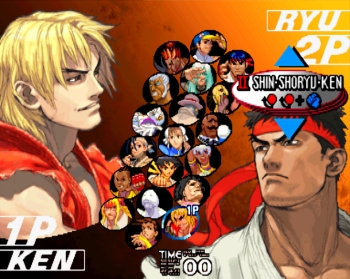
Each character has three Super Arts (SAs), but only one can be used in battle. When you pick your character, you also pick which Super Art you want.
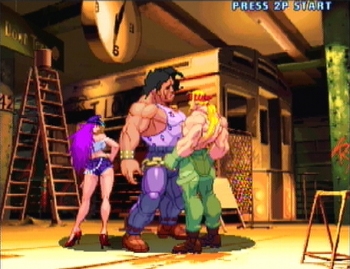
Some character pairs have special pre-fight animations, such as Alex and Hugo who recreate the Wrestlemania III stare down between Hulk Hogan and André the Giant.

Pressing both Hard Punch and Hard Kick at the same time performs a Personal Action (taunt), and in Third Strike they actually have small in-game character-specific benefits.
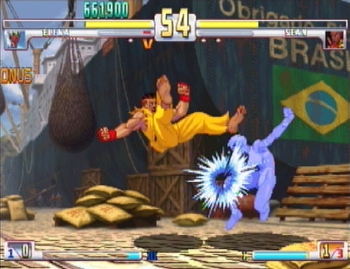
The blue aura on Elena means she has successfully parried Sean’s incoming kick, and now Sean is screwed. She has to be quick though because the punishment window is small.
Review by Jay Wilson We used to joke that Street Fighter II would never die—that Street Fighter III would never materialize (much less Street Fighter IV), and we’d be doomed to see SF2 upgrades for the rest of time. Ultimate Super Omega Street Fighter II Turbo Championship Edition: Hyper Tesseract Mode. Then to our amazement in 1997 Capcom released Street Fighter III: New Generation ... and not long after came SFIII: Second Impact ... and finally Third Strike in 1999. And it rocked. Street Fighter III took the next step with its sprites, and in 2012 it’s still one of the most impressive looking 2D games. Most fighting games have minimal animation for their character’s idle stance—a subtle rise and fall of their fists—just enough to keep the onscreen avatar “alive.” In SF3, though, pick Dudley and watch the gentleman boxer’s footwork. He does a little boxer’s dance, changing up which foot and which glove leads; and look how many frames it goes before the animation loops. Furthermore, this game is littered with great little details like the Shoto fireballs where the released energy blows back Ken’s hair, Ryu’s headband, and the fabric of Akuma’s gi. It’s almost as if the animators took all the ridiculous moves and said “if these things were possible, what laws of physics would apply to them?” My personal favorite? Chun-li’s spinning bird kick. Check out how she takes a moment to wind up before launching herself into the air; then as she dismounts at the end, pay attention to how the momentum continues to carry her so that her clothing keeps going and takes a second to finally settles back down. If a person could pull off something so crazy, I’m convinced this is how it would look. Plus, Street Fighter III has the perfect level of character development for a fighting game (as in it gives quickie hints and nothing more.) Arcade mode endings, victories poses, and the aforementioned animation touches unique to each character—their body language, how they move/attack/taunt—but Street Fighter III also has very brief bits of business before fights such as Ryu, the stoic wandering warrior, dropping his duffle bag and taking up his fighting stance. It takes less than a second, but conveys Ryu’s “anywhere anytime” dedication as he’s willing to drop everything and throw down. When Ryu faces Ken, the two bump fists, and again in less than a second—with a single gesture—it conveys these two’s friendship as they wordlessly wish one another luck. And that’s really all these games need. Besides, fighting games always have a noticeable pause before the actual fight begins; this is done to ensure neither player is taken by surprise. The announcer usually says “Round One” but he might as well be saying “Ready? FIGHT!” Street Fighter III uses an existing pause for its pre-fight animations and thus doesn’t feel like it’s wasting anyone’s time. After spending five games with the original Street Fighter II cast, Capcom did the most intelligent thing it could: ditched them in favor of a new cast. Well, mostly a new cast. Ryu, Ken, Akuma, and Chun-li return, but new characters comprise the remaining fourteen. And, here Capcom made another wise decision: giving the new cast some passive traits similar to classic Street Fighter II characters, but putting a whole different spin on them. Take Necro for example. Bald and skinny, he has the ability to stretch his limbs not unlike Dhalsim. He even has the descending “drill” moves like Dhalsim (performed with the same button inputs.) However, not only does Necro lack a fireball (Yoga Fire/Yoga Flame), lack a teleport, but he can also channel electricity through his skin (a la Blanka)—which, by the way, is initiated like a dragon punch (unlike Blanka) and sustained by mashing punches (like Blanka.) Necro even has a special move where he stretches his arms out to either side and spins around (think hurricane kick except with fists.) Looking at the rest of the cast, Hugo has a 360 command throw reminiscent of Zangief’s spinning pile driver, Yang has a series of three back-to-back strikes similar to Fei Long’s Rekkaken, Dudley (a boxer) has no kicks exactly like Balrog (SF2’s boxer), and Remy steals not only Guile’s sonic boom but also his flashkick and down+roundhouse double sweep. But I have to reiterate: these resemblances remain strictly on a surface level. Remy doesn’t have to charge as long as Guile did plus he has both high and low sonic booms (not to mention a powered up EX version that spits out one of both, plus a Super Art that launches a barrage of high and low sonic booms) furthermore Remy has another kick that propels him across the screen. Not only do these characters play different from the Street Fighter II cast, but they give off opposite vibes too. Balrog (boxer) was about brute strength—getting in and pummeling his prey to a pulp. But Dudley is a gentleman who shows up in a sports car, uses tricky tactics and mind games to get his damage, he tosses out a roses for his taunt, and for his victory pose his butler arrives via helicopter to serve tea. Guile was a trained soldier who fixed his flattop between battles; Remy hails from France and seems narcissistic, pessimistic, and bored (given a moment of idle time, he’ll brush his long blue hair out of his face). Blanka roared for his victory pose; Necro sings. 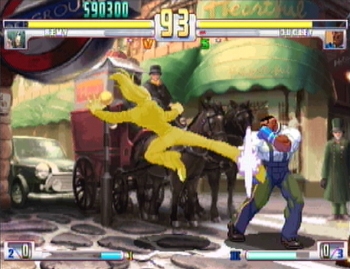
Believe it or not, the idea of a powered up special move evolved from Darkstalkers: The Night Warriors although in that game you had minimal control over when it came out.
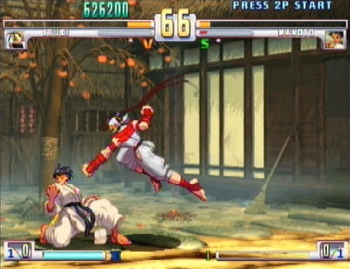
By pressing Medium Punch + Meduim Kick, you can perform a universal overhead that hops over low attacks and hits crouching characters. Some characters have more (sometimes better) overhead options, but it’s nice that everyone has something.

These two only get weirder and weirder. Necro’s girlfriend (Effie) shows up at the end of the match, and one of Oro’s Supers lets him summon bricks, rocks, little statues, and other debris to help him fight.
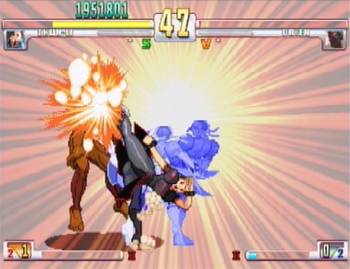
One of the most feared characters (and Supers Arts) in the game since Chun-li can combo off a hit-confirmable crouching medium kick. Translation: if you know what you’re doing and have quick enough reflexes, this thing will never miss. Ever.
Now, let me be clear. I like that these new characters pay tribute to their predecessors, but that doesn’t necessarily mean I like them. Street Fighter II had both serious and silly characters, and Street Fighter III continues that tradition; however, Third Strike takes things a little too far. This game actually has both a character named after a letter and a number: Q and Twelve. The former being a masked figure in a trench coat who mumbles as he charges across the screen to beat the living daylights out of his opponent, and the latter being an experimental being (like Necro) who has some minor T1000 morph properties going on. He can turn his body into a glider, he can go invisible, his arms can become tentacles or spikes, and his X.C.O.P.Y. Super Art allows him to temporarily become his opponent and gain all their abilities. And I can’t leave out Oro, who is something of a design paradox. Let me go off on a tangent for a moment. People often mistakenly associate good art with warm and fuzzy feelings and bad art with repulsion. But sometimes, say in suspense movies, the point of the imagery and music is to make the audience uneasy by instilling dissonance. A sense of wrongness. Putting together things that don’t go together. Oro is the character equivalent to that concept. I’ve never seen a more disturbing character in a fighting game. Ever. But at the same time I can’t call his design incompetent because there’s a deliberate dissonance to every inch of Oro. He’s a small shriveled prune of an old man who barely looks human with his red eyes, six cartoony hairs perpetually blowing in the wind and one arm tucked inside his tattered robes. During his victory pose, he looks around with bird-like movements, and for his taunt he falls asleep with a bubble of snot coming out of his nose. He looks famished with very prominent ribs and receding stomach, yet he has very developed muscle structure and can pick up other characters with one hand and slam them into the ground numerous times. Like I said, Oro is wrong on every level, but it’s a precision wrongness that I don’t feel comfortable calling “bad.” I do, however, strongly question the decision to put such an unorthodox character in the game. Anyway, my least favorite character has to be Gill, the final boss who is genuinely badly designed. I could focus my complaints on his stupid red/blue flesh tones which makes him look like one of those rabid obsessed fans at a sporting event (the long blonde hair doesn’t help either), but there’s bigger problems with this character. Gill has a number of advantages in priority, speed, range, damage, and juggle potential—and I’m fine with that too (well, except the insane juggles, but for the sake of argument let’s pretend those are just peachy.) He’s the boss; he should be formidable. The real problem with Gill is he breaks the fundamental rules of Third Strike and the entire Street Fighter franchise. First, he has one of the most annoying Super Arts (SAs) called Resurrection where if his Super meter is full when he’s defeated he will rise, and his life bar will refill. Now, there’s nothing wrong with Gill getting life back (Elena can do it too) ... but Resurrection, unlike every other Super Art in the game, initiates automatically. The player does not have to do anything to trigger it. It just happens which is flat out wrong. If the player does nothing, then they should get nothing. If the player wants something to happen, they should have to make it happen. Period. Second, in all Street Fighter games a character can block normal attacks without taking damage; however, a character blocking a special move will take reduced “chip” damage. Contrary to every other character in the SF universe, Gill deals chip damage with his normal Fierce Punch and normal Roundhouse kick. Third, the rest of the cast only has access to one Super Art at a time. Gill has access to all of his Super Arts (one of which activates automatically, so he’s guaranteed to use it.) Fourth, Super Arts can be wasted—they can miss, they can be parried, or an opponent can hit you out of it. Gill’s third Super Art, Seraphic Wing, hits everything on screen (ie, it cannot miss), it cannot be parried, and it can knock out half a life bar in chip damage (God help you if you fail to block it.) Now, you can hit Gill out of Seraphic Wing during its startup (it’s vulnerable for the first second), but even if you do ... it doesn’t count. His Super meter stays full, meaning he can just try again ... and again ... and continue trying until he nails you. In other words, Seraphic Wing cannot be wasted. Character complaints aside, I love the fighting engine in Street Fighter III. Most notably the parries. Tapping forward as an attack approaches will neutralize it and theoretically create an opening; however, a parry only works on the one hit, meaning a two-hit dragon punch requires two consecutive parries and Chun-li’s seventeen hit SA2 requires seventeen lightning fast parries. This translates to new mind games where let’s say Ibuki jumps in on Sean. In past Street Fighters the options were attack or block. But now, Sean can attempt to hit her out of the air which Ibuki can parry; he can play safe and block, possibly taking chip damage; or he can attempt to parry an incoming attack hoping he parries all of Ibuki’s hits. But Ibuki doesn’t have to attack; she can just land and then throw him. Of course, Sean has further options I won’t get into. The point is parries create options, and options generally help sculpt a good game. On that note, the reason I adore Third Strike is that parries render fireball wars completely and utterly useless. Shoot mindless hadoukens all you want. I can parry them all damn day long. I can even jump in, parry the Shoryuken, and take my time deciding which combo to punish you with as you come down from that ineffective dragon punch. Now projectiles finally feel like a real tactical element that requires skill to get somewhere with; now you have to either catch them by surprise, place them in situations where they can’t parry, or find awkward scenarios where they are too preoccupied with a complicated input to parry. And let’s not forget the game still has a number of moves where a character charges across the screen to attack (Urien’s Chariot Tackle, Dudley’s Machine Gun Blow, Elena’s Rhino Horn, and pretty much everything Q does). Fireballs are perfect for discouraging those. 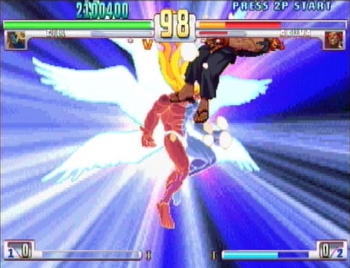
Notice the timer. Notice Akuma’s life bar. This is not photoshopped. This is not a trick. Gill’s Seraphic Wing (which I affectionately call “Rainbow of Death”) is that fucking overpowered.

As much as I love Third Strike, even I have to admit it has a very uncomfortable mix of characters. If only I knew back then that one day I’d play Street Fighter IV with less exotic newcomers who are somehow infinitely more retarded.
I also really like the variety of Super Arts available in Third Strike. Like any other fighting game, most Supers do high damage; however, Street Fighter III has a few creative ones. Alex’s Stun Gun Headbutt is a throw (unblockable, but hard to connect) that does very little damage; however it’s guaranteed to put his opponent in a vulnerable stunned state meaning Alex gets a free combo afterwords. Ryu can charge up and fire an unblockable Denjin Hadouken which inflicts a decent amount of both normal damage and stun damage depending on how long he holds the charge. Yun and Yang both have Supers that give them shadow trails which can lead to devastating mixups and combos as the shadows can hit too. Elena can heal herself. Makoto’s Tanden Renki increases her damage, but makes it so she can’t block (she can still parry, but can’t block.) Then there’s Urien’s Aegis Reflector which is a wall-shaped projectile that gets behind his opponent and hovers there, cutting off their retreat; then a skilled Urien can unleash attacks that knock his prey into the Reflector which bounces them back towards Urien so he can continue to combo the hell out of them. Going even further than that: each Super Art has its own distinct meter. Some meters are short, others are long; some Super Arts max out with only one bar while others allow the character to stock up to three. Not only does this mean Hugo can choose between a one shot Gigas Breaker (SA1) or possibly two consecutive Hammer Frenzies (SA3), but there’s also EX moves (powered up special moves) which use a smaller amount of meter. A player may go with Hugo’s Megaton Press (SA2) for its two long stocks solely because it means more EX moves without ever actually using Megaton Press (which is anti-air anyway, and no one in their right mind jumps in on Hugo with an SA2 ready.) Anyway, the name of the game is options, and Street Fighter III has plenty of them. Sure, Makoto’s SA3 might be a stupid choice competitively, but it’s there and perfect for casual play. If a player wants to screw around with crazier Super Arts, they can; if a player wants to streamline their game and use only the most effective tools, well, there’s an SA for that too. Everyone wins. | ||||||||||||||||||||
|
| ||||||||||||||||||||
